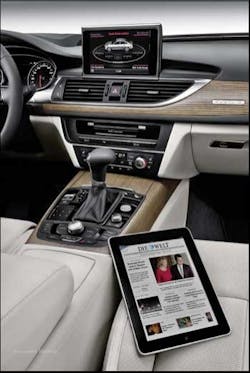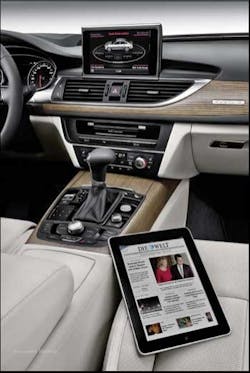Will automotive WiFi be productive or problematic?
Mobile workers may no longer have to hunt for hotspots, but network managers should be alert.
by Patrick McLaughlin
The advent of WiFi-style wireless local area network (LAN) access points inside vehicles may be the proverbial blessing and curse for professionals who deal with structured cabling on a daily basis. And whether it proves to be a blessing or a curse is likely to depend on just what you do with cabling systems.
For contractors who have spent countless hours inside their vehicles in search of wireless LAN connectivity, the idea of an in-vehicle hotspot holds great promise for increased productivity. But what about enterprise LAN managers who constantly monitor their 802.11-based wireless LANs and take all practical measures to detect rogue access points? To them, the idea that a traveling hotspot can pull into the garage at any moment might be unsettling.
In-vehicle WiFiThis photo, supplied by Automotive Rhythms, shows the interior of an Audi A8 equipped with up to 7.2-Mbit/sec wireless LAN connectivity via UMTS.
In simple terms, in-vehicle WiFi is a product of technological advancement. Market-research firm In-Stat (www.instat.com) recently reported on the technology application in a study covering WiFi chipset markets worldwide. In-Stat principal analyst Allen Nogee said, "The cost of adding mobile hotspot ability to a broadband-capable system, such as OnStar, is only roughly $25 per car or less. In fact, Ford has announced it is doing just that, adding WiFi to all SYNC-2-equipped vehicles starting this year. Ford even made headlines when it announced it was using a car's built-in WiFi to configure and customize each vehicle in the factory where it is being built."
Nogee added that, "This industry is really just beginning. This model year several manufacturers have announced products. Ford, Audi and a few others are jumping in. I think automakers will include this feature in many cars because it's cheap, and the services revenue potential is high. Look at OnStar as an example. Mobile WiFi is very similar."
Whether or not an automobile equipped with WiFi will have the same transmission-distance capabilities as, for example, an 802.11ag access point is not entirely clear. Nogee's research was focused exclusively on WiFi chips. When asked if the chips used in automobiles will be the same as those used in other devices, he responded, "The answer is yes and no. The models of chips used in autos is the same as those used in phones and other applications, but they have to meet higher specs for temperature and other factors that are involved in an auto. That makes these chips much more expensive than off-the-shelf components."
Have you driven a hotspot lately?
Ford splashed onto the in-vehicle WiFi scene at the 2010 Consumer Electronics Show. At that time the company's chief engineer for HMI, driver controls and infotainment John Schneider said, "Technology is evolving at such speeds, particularly on the wireless front, that obsolescence becomes a real problem. We've solved that problem by making SYNC work with just about any technology you plug into it. By leveraging a user's existing hardware, which can be upgraded independent of SYNC, we've helped ensure forward compatibility with whatever connectivity technology comes next."
Vehicles equipped with MyFord Touch capability feature a WiFi receiver signal that provides Internet access when the vehicle is in park, using the touch screen. Additionally, an owner can insert a compatible USB mobile broadband modem into the vehicle's USB port to produce a secure wireless connection that will be broadcast throughout the vehicle, allowing passengers with WiFi-enabled mobile devices to access the Internet while on the go. The two USB 2.0 ports included in the MyFord Touch Media Hub allow owners to use a variety of devices, including a mobile broadband modem. Through software updates, SYNC can be adapted to connect with newer devices as well.
Ford emphasized the fact that the system is factory-installed, unlike competitive systems available at that time. "The hardware is seamlessly integrated into the vehicle, whereas competitors' systems are dealer-installed and require a bolt-in receiver and transmitter," the company said. As Nogee pointed out, over the past year-plus other automakers have joined the ranks, offering built-in WiFi capability.
Ford noted in early 2010 that the signal generated through its system will broadcast throughout the vehicle and that the default security is set to WiFi Protected Access 2 (WPA2). "When SYNC sees a new WiFi device for the first time, the driver must specifically allow that device to connect, preventing unauthorized users from piggybacking on the SYNC-provided signal," Ford said.
Uninvited visitor?
That level of assurance for consumers does not answer the question of whether or not a WiFi-equipped Ford vehicle has the potential to disrupt the activity of a nearby wireless LAN. For example, might such a moving hot spot be the equivalent of a "rogue" access point if it pulls into a company garage and is located just feet from the organization's 802.11-based wireless LAN?
In an application note for its OptiView Series II Integrated Network Analyzer, network, cabling and wireless test-equipment provider Fluke Networks reminds us, "Rogue access points are not usually set up by a hacker or malicious employee, but more often by an employee who unwittingly installs an access point without the knowledge of the IT department." In this case, it would be an employee who unwittingly pulls an access point into a parking space without the knowledge of the IT department. The Fluke Networks note continues, "Once an access point is established on the network, a hacker can access your corporate network simply by associating with this rogue access point. Therefore, the detection of wireless access points has become a major source of activity for many enterprises." Ford's WPA2 encryption does something to prevent such hacker activity, but according to Ford, it is up to the vehicle owner to decide whether or not to allow access to another device.
Even if the possibility of an automobile acting as a rogue access point never comes to fruition, enterprise wireless LAN managers could face challenges having to do with channel mapping. Fluke Networks' product manager for portable network tools Carolyn Carter has spoken and written about wireless LAN testing, security, interference and other issues. On the issue of channel mapping she offered the following cautious guidance. "Channel mapping for a wireless LAN can be confusing and if not performed correctly, can degrade the network's performance. Many users are challenged to correctly channel-map their wireless LANs.
"In the 2.4-GHz operating band are 14 channels. In the United States only 11 of those 14 channels can be used. And only three of those channels do not overlap with at least one other channel. The de-facto non-overlapping channels in the U.S. are 1, 6 and 11. In order to effectively channel map your wireless LAN, you will need to know which channels you will use, which channels you are considering using, and which channels your neighbors are using.
"Channels in the 2.4-GHz band are approximately 20-MHz wide and are spaced approximately 5-MHz apart. Areas where there is overlap are referred to as adjacent channels; they cause rather severe interference that will cause significant problems for a wireless LAN. Controlling or eliminating adjacent channels, unfortunately, is not entirely in the hands of a network administrator. For example, even if a wireless LAN uses the non-overlapping channels 1, 6 and 11, a neighbor using channel 3 will create overlapping channels, causing interference between neighboring networks."
Path to proliferation
In early 2011 Ford celebrated a milestone by installing its SYNC in-vehicle connectivity system on its 3 millionth vehicle in North America. The company also boasted that for the 2011 model year, 80 percent of the time SYNC has been available for purchase as a $395 option in a vehicle, the purchaser has chosen it. The technology comes as a standard feature in Lincoln brand vehicles.
As of the 2011 model year, Audi also offers an optional factory-installed hotspot in its A8. Drivers of that $80,000 vehicle can have access to Universal Mobile Telecommunications System (UMTS) connectivity, which is essentially 3G/4G, with wireless transmission speeds up to 7.2 Mbits/sec.
As this technology gets built into more automobiles, it will represent one more communication device that could reside on the periphery of a corporate 802.11-based wireless LAN or in-building distributed antenna system. Whether or not it is even a blip on the radar screen of corporate LAN administrators remains to be seen.
Patrick McLaughlin is chief editor of Cabling Installation & Maintenance.
Past CIM Issues

